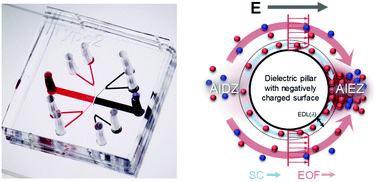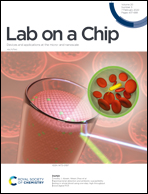Surface conduction and electroosmotic flow around charged dielectric pillar arrays in microchannels†
Abstract
Dielectric microstructures have been reported to have a negative influence on permselective ion transportation because ions do not migrate in areas where the structures are located. However, the structure can promote the transportation if the membrane is confined to a microscopic scale. In such a scale where the area to volume ratio is significantly large, the primary driving mechanisms of the ion transportation transition from electro-convective instability (EOI) to surface conduction (SC) and electroosmotic flow (EOF). Here, we provide rigorous evidence on how the SC and EOF around the dielectric microstructures can accelerate the ion transportation by multi-physics simulations and experimental visualizations. The microstructures further polarize the ion distribution by SC and EOF so that ion carriers can travel to the membrane more efficiently. Furthermore, we verified, for the first time, that the arrangements of microstructures have a critical impact on the ion transportation. While convective flows are isolated in the crystal pillar configuration, the flows show an elongated pattern and create an additional path for ion current in the aligned pillar configuration. Therefore, the fundamental findings of the electrokinetic effects on the dielectric microstructures suggest an innovative application in micro/nanofluidic devices with high mass transport efficiency.



 Please wait while we load your content...
Please wait while we load your content...